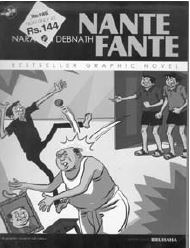 This was my first encounter with Narayan Debnath’s legendary comic strip that took birth in 1969 between the pages of a monthly magazine called Kishor Bharathi. The comic strip grew into comic books, and now the Nante Fante stories are available as animated films as well as full-colour publications in English and Bengali.
This was my first encounter with Narayan Debnath’s legendary comic strip that took birth in 1969 between the pages of a monthly magazine called Kishor Bharathi. The comic strip grew into comic books, and now the Nante Fante stories are available as animated films as well as full-colour publications in English and Bengali.
The Nante Fante comics have a simple premise—they capture the world of childhood as experienced in small-town and rural Bengal in the mid-20th century. The two main protagonists are a pair of boys nicknamed Nante and Fante (also spelled Nonte and Fonte/Phonte). They stay in a boarding school and are always up to mischief in the time-honoured fashion of fictionalized boarding school students (never having studied in a boarding school, I cannot vouch for the authenticity of that assumption). The two other main characters are a senior student called Keltuda who is the butt of the boys’ pranks and the Hostel Superintendent—Patiram Hari—an obese, gluttonous individual who seems pretty fond of doling out corporal punishment. Debnath has included all those elements that are sure to find favour with children—a senior who always loses out to the younger and smarter boys and a stern teacher who is a figure of fun, and whom the boys often get the better of. Mix in liberal doses of slapstick humour and simple plot lines—and you have a guaranteed readership! Nante Fante comics have been read for almost fifty years—an extremely creditable achievement!
Will they be read for the next fifty years or so? I don’t know. Some of the themes and humour seem dated. For instance, almost all the tales in this book seem to be about hunger and food, and how the boys as well as the teacher are ready to go any lengths to get their hands on some food. With the Bengal famine of the 40s in the background, such an obsession might have made sense in the 1970s and 80s, but the theme may not resonate with kids living in a world of plenty today. Also, it seems very wrong to me that Keltuda who is always on the losing end is dark-skinned and scrawny while the victorious Nante Fante are fair and of regular build.
The near total absence of women in the several Nante Fante books seems to presuppose a male readership, and remind me of another famous Bengali writer, Satyajit Ray, who created an almost male world in his Feluda books.
The illustrations are full of life and evoke laughter and even create empathy when one witnesses Keltuda getting battered and bruised in their several adventures.
Padma Baliga is a library consultant and an independent researcher whose interests include children’s and young adult books, gender studies and Indian literatures.
Review Details
</strong>

